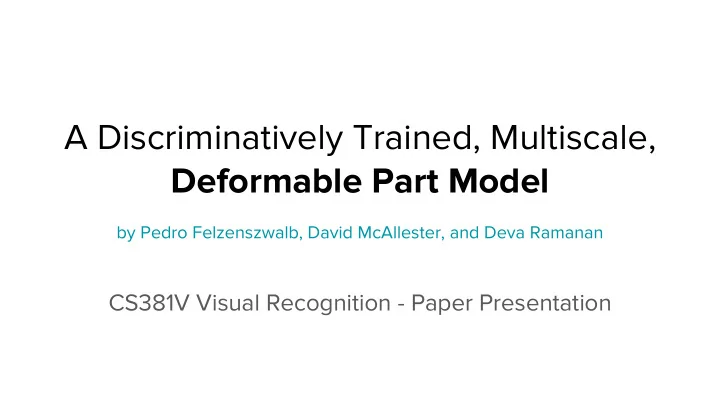

A Discriminatively Trained, Multiscale, Deformable Part Model by Pedro Felzenszwalb, David McAllester, and Deva Ramanan CS381V Visual Recognition - Paper Presentation
Slide credit: Duan Tran
Slide credit: Duan Tran
Deformable Part Model Slide credit: Pedro F. Felzenszwalb
Deformable Part Model Deformation Root Filter Part Filters Model Felzenszwalb, Pedro, David McAllester, and Deva Ramanan. "A discriminatively trained, multiscale, deformable part model." Computer Vision and Pattern Recognition, 2008. CVPR 2008. IEEE Conference on . IEEE, 2008.
Step 1: HOG Pyramid 8 x 8 Felzenszwalb, Pedro, David McAllester, and Deva Ramanan. "A discriminatively trained, multiscale, deformable part model." Computer Vision and Pattern Recognition, 2008. CVPR 2008. IEEE Conference on . IEEE, 2008.
Step 1: HOG Pyramid ● Normalize w.r.t. the sum of histogram values in each 2 x 2 block containing the cell. 4 x 9 descriptor: Felzenszwalb, Pedro, David McAllester, and Deva Ramanan. "A discriminatively trained, multiscale, deformable part model." Computer Vision and Pattern Recognition, 2008. CVPR 2008. IEEE Conference on . IEEE, 2008.
Step 1: HOG Pyramid Felzenszwalb, Pedro, David McAllester, and Deva Ramanan. "A discriminatively trained, multiscale, deformable part model." Computer Vision and Pattern Recognition, 2008. CVPR 2008. IEEE Conference on . IEEE, 2008.
Filter H is a w ⨉ h ⨉ 4 ⨉ 9 vector. Slide credit: Pedro F. Felzenszwalb
Slide credit: Pedro F. Felzenszwalb
Pascal 2007 Dataset Slide credit: Pedro F. Felzenszwalb
Step 2: Initialize Root Filter Set Filter Size Scale to Filter Size Train Root Filter Felzenszwalb, Pedro, David McAllester, and Deva Ramanan. "A discriminatively trained, multiscale, deformable part model." Computer Vision and Pattern Recognition, 2008. CVPR 2008. IEEE Conference on . IEEE, 2008.
Step 2: Train Root Filter Train Filter ? Unscaled Image Find best placement in HOG pyramid. At least 50% overlap w/ ground truth. Felzenszwalb, Pedro, David McAllester, and Deva Ramanan. "A discriminatively trained, multiscale, deformable part model." Computer Vision and Pattern Recognition, 2008. CVPR 2008. IEEE Conference on . IEEE, 2008.
Step 2 Summary 1. Set filter size based on statistics in the data. 2. Train on unoccluded examples with SVM. ○ Scale each example to match the filter size. ○ Random subwindows of negative images give negative examples. 3. Find the best filter placement in the HOG pyramid for each training image. ○ Un-scaled training images. At least 50% overlap. ○ 4. Re-train using best placements. ○ Same negatives as before. ○ Iterate twice. Felzenszwalb, Pedro, David McAllester, and Deva Ramanan. "A discriminatively trained, multiscale, deformable part model." Computer Vision and Pattern Recognition, 2008. CVPR 2008. IEEE Conference on . IEEE, 2008.
Step 3: Initialize Part Filters ● Train latent SVM on the full model: ○ β = ( F 0 , F 1 , …, F 6 , a 1 , b 1 , …, a 6 , b 6 ) are model parameters. Trained Root Filter Felzenszwalb, Pedro, David McAllester, and Deva Ramanan. "A discriminatively trained, multiscale, deformable part model." Computer Vision and Pattern Recognition, 2008. CVPR 2008. IEEE Conference on . IEEE, 2008.
Step 3: Train Object Model Train Model ? Score of placement z . SVM Objective: Labeled training data ( x i , y i ). Felzenszwalb, Pedro, David McAllester, and Deva Ramanan. "A discriminatively trained, multiscale, deformable part model." Computer Vision and Pattern Recognition, 2008. CVPR 2008. IEEE Conference on . IEEE, 2008.
Step 3 Summary 1. Initialize 6 parts. Position in areas of highest energy of root filter. ○ 2. Train latent SVM on the full model: ○ β = ( F 0 , F 1 , …, F 6 , a 1 , b 1 , …, a 6 , b 6 ) are model parameters. ○ For each positive example, find best overall placement z . ○ Use high-scoring regions in negative images as hard negatives . ○ Iterate 10 times. Each time cache as many hard negatives as can fit into memory. ■ Remove no-longer hard negatives. Score of placement z . SVM Objective: Labeled training data ( x i , y i ). Felzenszwalb, Pedro, David McAllester, and Deva Ramanan. "A discriminatively trained, multiscale, deformable part model." Computer Vision and Pattern Recognition, 2008. CVPR 2008. IEEE Conference on . IEEE, 2008.
Results ● Decent performance: ○ PASCAL 2007 challenge. First place in 10/20 classes. ○ ○ Second place in 6/20. ● Fast: ○ 3-4 hours training. ~2s evaluation. ○ Car Model Felzenszwalb, Pedro, David McAllester, and Deva Ramanan. "A discriminatively trained, multiscale, deformable part model." Computer Vision and Pattern Recognition, 2008. CVPR 2008. IEEE Conference on . IEEE, 2008. Felzenszwalb, Pedro F., et al. "Object detection with discriminatively trained part-based models." Pattern Analysis and Machine Intelligence, IEEE Transactions on 32.9 (2010): 1627-1645.
Person Bottle Bike Felzenszwalb, Pedro, David McAllester, and Deva Ramanan. "A discriminatively trained, multiscale, deformable part model." Computer Vision and Pattern Recognition, 2008. CVPR 2008. IEEE Conference on . IEEE, 2008.
Felzenszwalb, Pedro F., et al. "Object detection with discriminatively trained part-based models." Pattern Analysis and Machine Intelligence, IEEE Transactions on 32.9 (2010): 1627-1645.
Best overall results with all three components. Slide credit: Pedro F. Felzenszwalb
Conclusion ● HOG pyramid representation. ● Root filter + part filters + latent placement variables. ○ Train with latent SVM. ● Hard negative mining. ● Possible extensions? ○ Deeper part hierarchies (parts of parts). ○ Multiple viewpoint models (front, side, back, etc.). ○ 3D pose estimation. ○ Visual words for parts: multi-class detection. Felzenszwalb, Pedro, David McAllester, and Deva Ramanan. "A discriminatively trained, multiscale, deformable part model." Computer Vision and Pattern Recognition, 2008. CVPR 2008. IEEE Conference on . IEEE, 2008.
Object Hypothesis Computation HOG Features Root Response Object Model ⨉ Combined Score Part Responses + Deformation + ⨉ ... ... ⨉ 2x Resolution HOG Felzenszwalb, Pedro F., et al. "Object detection with discriminatively trained part-based models." Pattern Analysis and Machine Intelligence, IEEE Transactions on 32.9 (2010): 1627-1645.
</presentation>
Recommend
More recommend